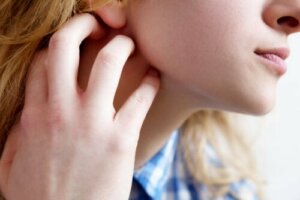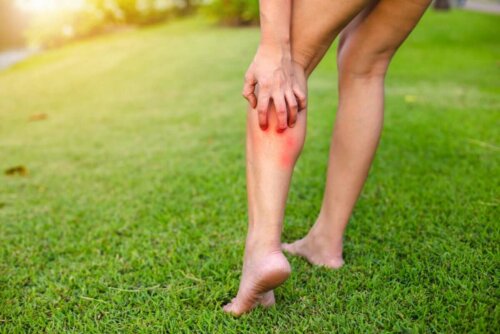Itchy Skin or Pruritus: Symptoms, Causes, and Recommendations


Written and verified by the doctor Karina Valeria Atchian
Itchy skin, or pruritus, is often a reason for adults and children to visit a medical specialist. There are many varied possible causes, from banal issues to more serious problems.
Specialists define it as an annoying feeling that causes the desire to scratch yourself. It’s usually a consequence of the body’s reflex response to immune or chemical stimuli. It’s almost always found to involve the substance histamine.
What is pruritus, or itchy skin?
It’s important to clarify that itchiness is a symptom, not an illness in its own right. As such, it can take a wide variety of forms, with some that may not be related to the skin. It can also form in a localized or generalized way.
It’s important to keep an eye on it from the beginning; are there any factors that triggered it? What alleviates it? Has this happened before? Has something treated it before? If so, what was the body’s response to it? All of this will serve as a diagnostic guide and help to decipher the origin.
Acute pruritus is where the symptoms last for less than six weeks. If it lasts longer than that, it becomes a chronic variation. It can occur on the scalp, torso, or extremities.

You may also be interested in: 10 Causes and Types of Skin Rashes
Main causes of itchiness on the skin
As we have already mentioned, primary skin lesions may accompany the itchy skin. If that’s the case, you may have a dermatological disorder.
On the other hand, in those without skin lesions, or those that only have secondary damage caused by the itching, it’s likely to be an external cause. We include neurological and psychogenic disorders in this category.
Those with pruritus and primary skin lesions
The most common skin diseases that cause generalized itchiness are the following:
- Urticaria (hives): characterized by the presence of welt-like lesions that can get bigger or fuse together and disappear.
- Scabies: an infection caused by an ectoparasite. It’s a variation of mange.
- Prurigo: fairly common among children, with a strange nodular appearance.
- Atopic eczema: inflamed patches or plaques in the context of atopic and contact dermatitis.
- Varicella (chickenpox): a viral infection that develops as blisters on the skin.
- Gilbert’s pityriasis rosea: pink, scaly lesions.
- Psoriasis: an issue characterized by the presence of scales caused by an autoimmune disorder.
Those with pruritus without primary skin lesions
Here, in addition to the most common ailments, we present a variety of casual disorders that include the following:
- Chronic renal insufficiency: when the kidneys don’t function in a normal way.
- Oncologic illnesses: most commonly, blood-related illnesses like polycythemia vera or lymphoma.
- Intra- or extrahepatic cholestasis: where bile doesn’t flow in the normal way.
- Hyper- or hypothyroidism: abnormalities in the levels of hormones released by the thyroid glands.
- Dry skin or xerosis: the elderly need special consideration here, as itchy skin is common among older adults. It’s possible that dehydration is the most common cause for that demographic, although it could be due to other causes. It usually appears in the lower extremities.
Localized pruritus
Localized pruritus that occurs without a rash suggests the possibility of psychogenic or neuropathic itching. In particular, the symptoms associated with a burning sensation, pain, or a loss of feeling can occur in these people.
This is due to nerve-conduction disorders that are linked to neuropathies. The peripheral nerves poorly transmit information and generate the feeling of itchiness within the skin, causing the person to constantly scratch themselves.

Have a look at: Simple Types to Keep Your Skin Hydrated
General care until you receive a proper diagnosis
Pruritus is a common disorder, but specialists still don’t fully understand the pathogenic mechanisms that cause the sensation of itchiness. A key part of the evaluation for these disorders relies on the presence of a primary skin disorder.
If primary skin lesions are identified, but the diagnosis remains uncertain, a skin biopsy may be useful. In general, the absence of clear and visible issues implies that the cause is extra-dermatological.
Despite the fact that many of the origins are banal and the lesions often resolve themselves spontaneously, there are other forms that require medical attention.
When looking to determine the cause of your form of pruritus, it’s best to keep your nails short and clean, only scratching the affected area with the palm of your hand. Avoid tight clothing, try to wear cotton rather than synthetic fabrics or wool, and avoid prolonged, hot baths.
You should use neutral soaps and hydrating creams. Specialists also advise against the consumption of coffee, alcohol, or spicy foods, as these can all stimulate histamine release within the body. There are many options for treatment but it’s always best to prioritize a medical prescription.
All cited sources were thoroughly reviewed by our team to ensure their quality, reliability, currency, and validity. The bibliography of this article was considered reliable and of academic or scientific accuracy.
- Castells M. and col, Mast cell-derived mediators, retrieved on 14 Sep 2020, Evidence-based Clinical Decision Support- UpToDate. https://www.uptodate.com/contents/mast-cell-derived-mediators?search=histamina&source=search_result&selectedTitle=1~150&usage_type=default&display_rank=1
- Kasper y col., Principios de medicina interna de Harrison, edición número 19, Editorial McGrawHill.
- Rubinstein A., Medicina familiar y práctica ambulatoria, editorial médica panamericana. Primera edición, 2001.
- Fazio S., Pruritus: Overview of management, retrieved on 14 Sep 2020, Evidence-based Clinical Decision Support- UpToDate. https://www.uptodate.com/contents/pruritus-overview-of-management?search=prurito&source=search_result&selectedTitle=1~150&usage_type=default&display_rank=1
- Fazio S., Pruritus: Etiology and patient evaluation, retrieved on 14 Sep 2020, Evidence-based Clinical Decision Support- UpToDate. https://www.uptodate.com/contents/pruritus-etiology-and-patient-evaluation?search=prurito&source=search_result&selectedTitle=2~150&usage_type=default&display_rank=2
- SCOTT MOSES, M.D., Fairview Lakes Regional Health Care, Lino Lakes, Minnesota, Am Fam Physician. 2003 Sep 15;68(6):1135-1142.
- Villa-Arango, Ana María, Margarita María Velásquez-Lopera, and Ricardo Cardona. “Prurito crónico.” Revista Alergia México 66.1 (2019): 85-98.
- Chirinos, Maria Fabiola, et al. “Notalgia parestésica: el prurito anonimo.” Dermatología Venezolana 57.2 (2020).
- Belda, Lydia Landete, and Esther Escriche Catalá. “Caso clínico complejo de lesiones cutáneas por prurito de origen renal.” Enfermería Dermatológica 10.29 (2016): 34-36.
- del Valle Díaz, Sergio, et al. “Colestasis: un enfoque actualizado.” Medisan 21.7 (2017): 876-900.
- Lagos, Armando, Andrés Tirado-Sánchez, and Rosa María Ponce-Olivera. “Actualidades en el tratamiento del prurito crónico.” Dermatología Revista Mexicana 60.3 (2016): 229-246.
This text is provided for informational purposes only and does not replace consultation with a professional. If in doubt, consult your specialist.








